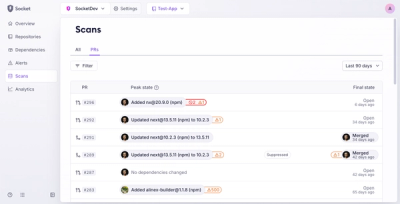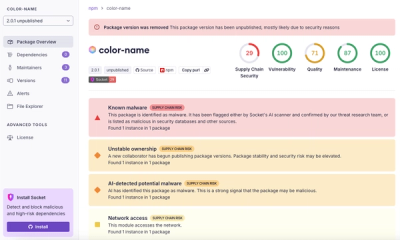
Security News
MCP Steering Committee Launches Official MCP Registry in Preview
The MCP Steering Committee has launched the official MCP Registry in preview, a central hub for discovering and publishing MCP servers.
A command line tool for generating Markdown documentation and .env files from pydantic BaseSettings.
The same way you are able to generate OpenAPI documentation from pydantic.BaseModel, settings-doc allows you to generate documentation from pydantic_settings.BaseSettings.
It is powered by the Jinja2 templating engine and Click framework. If you don't like the built-in templates, you can easily modify them or write completely custom ones. All attributes of the BaseSettings models are exposed to the templates.
pip install settings-doc
See settings-doc --help for all options.
Let's assume the following BaseSettings in src/settings.py of a project:
from pydantic_settings import BaseSettings
class AppSettings(BaseSettings):
logging_level: str
You can generate a Markdown documentation into stdout with:
settings-doc generate --class src.settings.AppSettings --output-format markdown
Which will output:
# `LOGGING_LEVEL`
**Required**
Similarly, you can generate a .env file for local development with:
settings-doc generate --class src.settings.AppSettings --output-format dotenv
Which will output:
LOGGING_LEVEL=
If you have a module with a single settings class or want to load multiple classes at once as a source, you can also use the --module option. The following example works exactly like the one above and will use the AppSettings class automatically.
settings-doc generate --module src.settings --output-format dotenv
If multiple classes contain a field with the same name, all instances will appear in the output.
You can add any extra field parameters to the settings. By default, settings-doc will utilise the default value, whether the parameter is required or optional, description, example value, and list of possible values:
from pydantic_settings import BaseSettings, Field
class AppSettings(BaseSettings):
logging_level: str = Field(
"WARNING",
description="Log level.",
examples=["WARNING"],
possible_values=["DEBUG", "INFO", "WARNING", "ERROR", "CRITICAL"],
)
Which will generate the following markdown:
# `LOGGING_LEVEL`
*Optional*, default value: `WARNING`
Log level.
## Examples
`WARNING`
## Possible values
`DEBUG`, `INFO`, `WARNING`, `ERROR`, `CRITICAL`
or .env file:
# Log level.
# Possible values:
# `DEBUG`, `INFO`, `WARNING`, `ERROR`, `CRITICAL`
# LOGGING_LEVEL=WARNING
You can find even more complex usage of settings-doc in one of my other projects.
It is possible to generate documentation into an existing document. To fit with the heading structure, you can adjust the heading levels with --heading-offset. Additionally, you can specify the location where to generate the documentation with two marks set by --between <START MARK> <END MARK>.
Let's assume your README.md looks like this:
# My app
This app is distributes as a docker image and configurable via environment variables. See the list below.
# Environment variables
<!-- generated env. vars. start -->
<!-- generated env. vars. end -->
When you run:
settings-doc generate \
--class src.settings.AppSettings \
--output-format markdown \
--update README.md \
--between "<!-- generated env. vars. start -->" "<!-- generated env. vars. end -->" \
--heading-offset 1
the updated README.md will get only the specified location overwritten:
# My app
This app is distributes as a docker image and configurable via environment variables. See the list below.
# Environment variables
<!-- generated env. vars. start -->
## `LOGGING_LEVEL`
*Optional*, default value: `WARNING`
Log level.
### Examples
`WARNING`
### Possible values
`DEBUG`, `INFO`, `WARNING`, `ERROR`, `CRITICAL`
<!-- generated env. vars. end -->
The settings_doc.render() function can be used to render the documentation in code. It returns a string with the rendered documentation. Using the Minimal example from the command line usage, the code usage is as follows:
from settings_doc import render, OutputFormat
print(
render(
class_name="AppSettings",
module="src.settings",
output_format=OutputFormat.MARKDOWN,
)
)
settings-doc comes with a few built-in templates. You can override them or write completely new ones.
To just modify the existing ones:
mkdir custom_templates
settings-doc templates --copy-to custom_templates
custom_templates to suit your needs. You can keep only the modified ones as settings-doc always falls back to the built-in ones.settings-doc generate \
--class src.settings.AppSettings \
--output-format dotenv \
--templates custom_templates
To create new ones, create a folder and then a Jinja2 template with a file names <OUTPUT_FORMAT>.jinja. Then simply reference both in the command line options:
mkdir custom_templates
echo "{{ field.description }}" > custom_templates/only_descriptions.jinja
settings-doc generate \
--class src.settings.AppSettings \
--output-format only_descriptions \
--templates custom_templates
By default, there are several variables available in all templates:
heading_offset - the value of the --heading-offset option. Defaults to 0.fields is a list of str / FieldInfo tuples. The string is the name of the settings attribute and the values come from BaseSettings.model_fields.values(). In other words, a list of individual settings fields and their names. If multiple classes are used to generate the documentation, FieldInfos from all classes are collected into fields. The information about original classes is not retained.classes - a dictionary, where keys are the BaseSettings sub-classes and values are lists of extracted FieldInfos of that class. This can be used for example to split individual classes into sections.Extra parameters unknown to pydantic can be stored as a dict in the json_schema_extra attribute.
To access information from the BaseSettings classes, use the classes variable in the templates:
{% for cls, fields in classes.items() %}
# {{ cls.__name__ }}
{% endfor %}
It's possible to use settings-doc as a pre-commit hook to keep your documentation up to date. There is one hook id per output format:
settings-doc-markdownsettings-doc-dotenvThere are two caveats:
--output-format) in the args section.additional_dependencies, specifying each package, that is imported in
your module. For example, if you use YAML loading for your settings, and you have import yaml in
your module, you have to specify it. Depending on how your imports are organized, you might need to
specify all of your dependencies.Example .pre-commit-config.yaml section provided below:
- repo: https://github.com/radeklat/settings-doc
rev: '3.0.0'
hooks:
- id: settings-doc-markdown
language: system
args:
- '--module'
- 'src.settings'
- '--update'
- 'README.md'
- '--between'
- "<!-- generated env. vars. start -->"
- "<!-- generated env. vars. end -->"
- '--heading-offset'
- '1'
additional_dependencies:
- "pyyaml>=5.3.1"
You can use the same hook to check if the documentation is up-to-date in CI:
pip install pre-commit
pre-commit run --all-files settings-doc-markdown # or other settings-doc-<output-format>
Consider caching the ~/.cache/pre-commit environment cache for faster subsequent runs.
--output-format: markdown, dotenv--update, optionally between two given string marks with --between. Useful for keeping documentation up to date.--templates.--heading-offset to fit into existing documentation.<VALUE>: <DESCRIPTION> if example values are tuples of 1-2 items.FAQs
A command line tool for generating Markdown documentation and .env files from pydantic BaseSettings.
We found that settings-doc demonstrated a healthy version release cadence and project activity because the last version was released less than a year ago. It has 1 open source maintainer collaborating on the project.
Did you know?

Socket for GitHub automatically highlights issues in each pull request and monitors the health of all your open source dependencies. Discover the contents of your packages and block harmful activity before you install or update your dependencies.

Security News
The MCP Steering Committee has launched the official MCP Registry in preview, a central hub for discovering and publishing MCP servers.

Product
Socket’s new Pull Request Stories give security teams clear visibility into dependency risks and outcomes across scanned pull requests.

Research
/Security News
npm author Qix’s account was compromised, with malicious versions of popular packages like chalk-template, color-convert, and strip-ansi published.